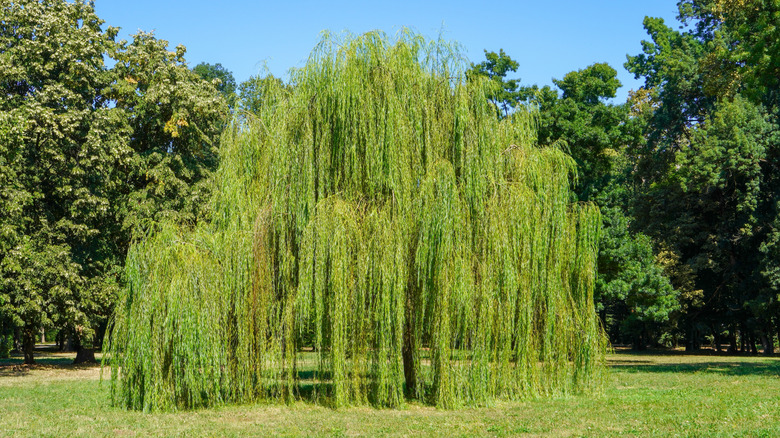The Popular Tree You Don't Want Growing Too Close To Your Home – And Why
Trees can be an amazing addition to any yard, offering shade and a home to many of our favorite songbirds. Trees can even cool the air around your home and absorb pollution. But there are some trees you may not want to grow near your house. The weeping willow (Salix babylonica) has an aggressive and large root system that can cause problems with utilities near your home or worse.
Willow trees have many famous fans, including Napoleon, who apparently took solace in one tree in particular during his exile on the island of St. Helena in 1815, several months after his defeat at Waterloo. A clipping from his favorite weeping willow was even planted at his grave. These pretty trees with the long, willowy branches thrive in USDA Plant Hardiness Zones 2 to 8. They're fast growers, adding on as much as ten feet a year before they reach maturity. Because they grow so quickly, weeping willows might not be the best trees to grow near your home. To make it worse, their root systems can grow aggressively too — sometimes three times as far as their branches and ten feet deep.
Weeping willows like growing near water, so if they're not near a water source, their roots will quickly stretch out to find one. That means weeping willow roots might cause costly damage to septic systems or other utilities. Even worse, willow roots can split driveways, sidewalks, or even your house's very foundation, which means you — not the willow — might end up weeping.
Keep weeping willows away from your home
Willow roots often take advantages of small fissures in concrete, making cracks worse. The best place for a weeping willow is at least 50 feet from your home. Also, weeping willows can attract disease and parasites, which doesn't make them the best shade trees.
If you're looking for a better alternative to a weeping willow, think about flowering dogwood (Cornus florida) or Japanese maple (Acer palmatum). These are pretty decorative trees that won't grow too tall and their roots aren't so aggressive that they'll damage your foundation or septic systems. The American hornbeam (Carpinus caroliniana) is a great option, too. It's a slow growing birch that's a nice accent to any home.
If you've already got a willow next to your home, be sure to keep lower branches trimmed and water the tree away from the house instead of close in to it. You may also want to think about installing a root barrier to protect your foundation. Root barriers can be physical barriers or chemical ones that help protect your home's foundation from aggressive root growth. If you want to know how to make a tree root barrier, start with a physical one, such as using plastic or landscaping cloth. You'll need to trench around the tree to help it work. The effectiveness of root barriers, however, is hotly debated. You might have better luck learning how to transplant weeping willow trees and move them away from your home.

